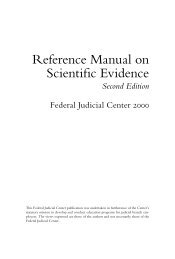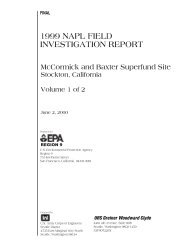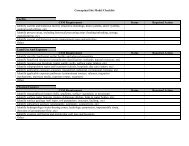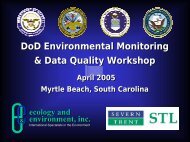Source Zone Delineation Demonstration Report - Triad Resource ...
Source Zone Delineation Demonstration Report - Triad Resource ...
Source Zone Delineation Demonstration Report - Triad Resource ...
You also want an ePaper? Increase the reach of your titles
YUMPU automatically turns print PDFs into web optimized ePapers that Google loves.
that the Wireline CPT sampler cannot obtain samples from the saturated zone. Thus, an alternativemethod is required to investigate potential source(s) below the groundwater elevation.6.2.2 Soil Vapor Extraction/DSITMS (SVE)The total estimated cost of a hypothetical SVE/DSITMS investigation is $125,100 (see Table 6-4)representing the lowest cost of the four hypothetical investigations considered as part of this analysis.The cost of the SVE/DSITMS is $90,160 (42%) less than the HSA investigation, $68,360 (35%) less thanthe DPT investigation, and $24,520 (16%) less than the WS/DSITMS investigation.The SVE investigation is qualitatively different than other hypothetical investigations because the initialphase of investigation involves the analysis of soil vapor extracted from a suite of 7 borings locatedwithin the suspected area of soil contamination. The borings may or may not be screened across differentdepth intervals. This comparison assumes that the 7 vapor extraction wells are installed fromapproximately 30 to 50 feet bgs. The on-site DSITMS provides soil vapor concentration data at veryshort time increments during step tests conducted at each vapor extraction well (see Section 4 of thisreport). In-the-field evaluation of the VOC concentration time-series data in the vapor phase narrows thesize of the suspected source area, and a limited-scope soil investigation consisting of 6 DPT borings isconducted to refine the characterization. The borings are advanced to 60 feet bgs with samplingbeginning at 20 feet bgs with a nominal 2-foot vertical spacing between samples. Soil samples areanalyzed using the on-site DSITMS.For this cost analysis, it is also assumed that a blower for SVE is available and does not need to bepurchased. If it is necessary to purchase a blower, the cost of the SVE investigation would increase byapproximately $5,000. In addition, it is assumed that the VOC time-series data is used to identify soilboring locations and that multiphase, multicomponent numerically modeling of the vapor phase is notrequired. Although extensive numerical simulation of the SVE step tests were performed as part of theOU 12 <strong>Source</strong> <strong>Zone</strong> <strong>Delineation</strong> <strong>Demonstration</strong> to evaluate the concentration time series data, the resultsappeared to have limited value in the refinement of the source location. Thus, the hypotheticalSVE/DSITMS investigation does not include numerical modeling of the vapor phase but recommends alimited-scope (6 borings) soil investigation for further refinement of the source zone. If two additionalborings are required to adequately refine the source zone, the additional expense is approximately $5,000.The cost advantage of the SVE investigation compared to the other hypothetical investigation techniquesis mainly associated with the reduced cost of field operations. The combined cost of the SVE step testsand the subsequent limited-scope DPT soil investigation is $63,940, including the cost of the on-siteDSITMS. This is $56,860 (47%) less than fieldwork and laboratory expenses for the HSA investigation,$47,820 (43%) less than for the DPT investigation, and $26,690 (29%) less than for the WS/DSITMSinvestigation.March 2003 6-10 OU 12 <strong>Demonstration</strong> <strong>Report</strong>Final










